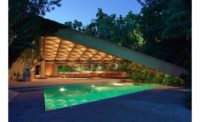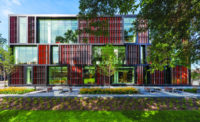Sinthian, Senegal
A favorite dictum of artist Josef Albers—known for his meditative, color-saturated paintings of overlapping squares—was “minimal means, maximum effect.” Forty years after his death, this idea is at the heart of a new initiative of the Connecticut-based Josef and Anni Albers Foundation: an artists' residency program and cultural center in rural Senegal. THREAD, as the center is called, is a sensitive work, designed pro bono by New York architect Toshiko Mori, that aims to weave together art, education, and cultural exchange under one roof.
Nicholas Fox Weber, executive director of the Albers Foundation, had been volunteering on and off for more than two decades with a local clinic here to combat high rates of infant and maternal mortality. He also dreamed of taking the Albers Foundation's mission—to educate the public about art—to Africa. After Mori designed an exhibition for the Cooper-Hewitt museum of the Alberses' work—Anni's textiles alongside Josef's Bauhaus-influenced furniture—the two became friends. Weber convinced Mori to bring her studio at Harvard's Graduate School of Design (GSD) to Senegal.
“I had been to different places, but not to Africa with students,” Mori says. “But Nicholas knew the local people and the context. We had the necessary connections and relationships.”
Through trips to two different towns in 2010 and 2012, the students identified a need for cultural venues to accommodate the rich Senegalese traditions of music and dancing. “The villagers loved our ideas and wanted to build everything we proposed,” says Mori. “It was like a dream for them.”
Fox Weber asked Mori's office to design an Albers Foundation artists' residence in Sinthian, where he had been working with the clinic, to foster cultural and artistic exchange between local and international artists. Mori, along with former student Jordan MacTavish (now a designer in her office), modified a scheme that emerged from the 2010 GSD studio—a low-slung brick building with a dramatic undulating bamboo roof that is as graceful as it is functional.
On a one-acre site near the local clinic, the designers oriented the structure to catch breezes and light, as well as to collect rainwater to compensate for the depleted aquifers. The building's figure-eight-shaped plan divides the interiors into flexible spaces. The designers located visiting artists' residency rooms on the northwest and southeast corners, while two circular central courtyards were meant as venues for performances and meetings. Brick was laid for walls perforated in a geometric pattern, inspired by Josef Albers's work, to provide ventilation and light while keeping out dust.
The building's most striking feature, its parametrically designed roof, minimizes the need for interior columns by resting on the brick walls. Composed of three lashed-together layers of bamboo topped with thatch, the sloped roof directs rainwater into canals, which drain into covered cisterns that can hold up to 73,860 gallons—one third of the annual domestic water usage in Sinthian. The roof will be put to the test for the first time this month, with the advent of the rainy season.
Most important, the architects were careful not to force a vision on the community, instead working within existing techniques, using local materials and construction methods, and giving local workers employment. Says Mori, “It's pro bono work, but not for pro bono's sake—it made sense in terms of economics.” The sale of one Albers painting at Christie's more than covered the construction cost, at $440,000. The remaining funds have gone to the first-year operating budget.
On opening day this past March, more than 1,000 people from Sinthian and surrounding villages flocked to the center. In one of the light-filled courtyards, community members delivered hours of speeches, dances, rap music, and skits. When not used for performances, dozens of children fill up the space, improvising soccer matches in the courtyards to escape the searing heat, and working on their schoolwork at dusk, when the center glows like a beacon.
“It is one thing to build a building,” says Mori, “but the most important thing is how you run it, how you program it, and how it becomes a truly sustainable program useful to the community.”
People
Owner:
Architect:
Personnel in architect's firm who should receive special credit:
Engineers:
General Contractor:
Photographer(s): Size: 11,300 square feet Cost: $227,715 Completion date: February 2015 |
Products
Exterior cladding
Roofing
Windows
Doors
Interior finishes
Special interior finishes unique to this project:
Other unique products that contribute to sustainability: |


















